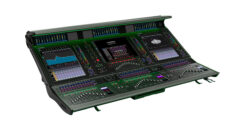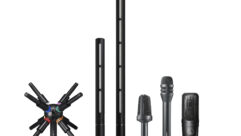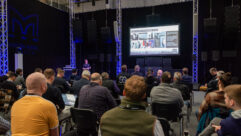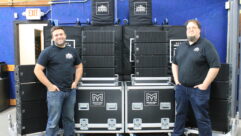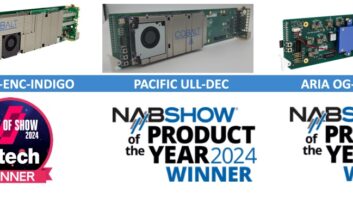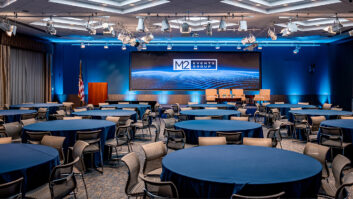Whether for the return of live sound, or the needs of installed sound applications, mixers and audio processors continue to be the heart of a range of systems and the glue. Here’s a look at some of the current options out there for selected consoles, mic mixers, and audio processors.
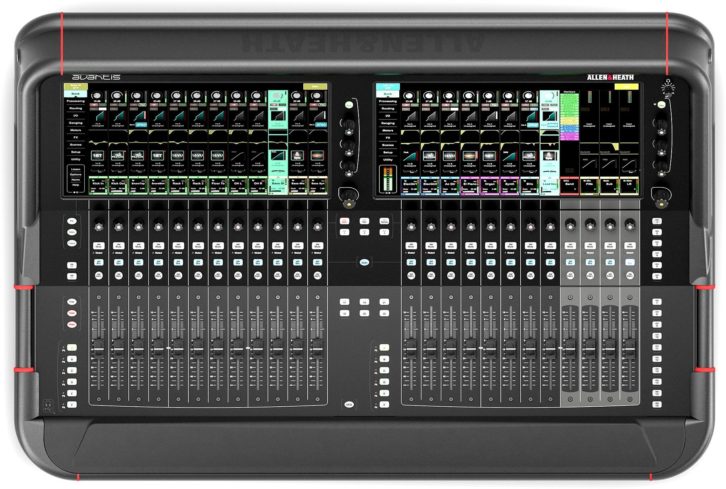 In March, the Allen & Heath Avantis got a major firmware V1.1 update, bringing powerful new features to the TEC Award-winning 64-channel digital mixer. Highlights include Avantis Director software, new processors from the dLive system including OptTronik, Hypabass, and Transient Controller, along with numerous enhancements and workflow improvements for engineers working in all environments, from houses of worship to live streaming. The core is Avantis Director software, a free Windows and Mac OS application enabling offline editing and online control capabilities. Offline mode can be used for the creation and editing of show files and system configuration, as well as serving as a training tool for new users. Online mode delivers full remote-control of the mixer, freeing the engineer from the mix position to make changes from anywhere in the venue. Additional features include the introduction of LCR+ mode for enhanced LCR mixing, Solo-In-Place functionality and a host of new routing and patching options for advanced processing and monitoring applications.
In March, the Allen & Heath Avantis got a major firmware V1.1 update, bringing powerful new features to the TEC Award-winning 64-channel digital mixer. Highlights include Avantis Director software, new processors from the dLive system including OptTronik, Hypabass, and Transient Controller, along with numerous enhancements and workflow improvements for engineers working in all environments, from houses of worship to live streaming. The core is Avantis Director software, a free Windows and Mac OS application enabling offline editing and online control capabilities. Offline mode can be used for the creation and editing of show files and system configuration, as well as serving as a training tool for new users. Online mode delivers full remote-control of the mixer, freeing the engineer from the mix position to make changes from anywhere in the venue. Additional features include the introduction of LCR+ mode for enhanced LCR mixing, Solo-In-Place functionality and a host of new routing and patching options for advanced processing and monitoring applications.
 The AMX Alero ALR-AEC-8 is a dedicated microphone mixer for up to eight microphones used for conferencing apps such as Lync or Skype in medium to large meeting rooms. It also supports VTC and audio conferencing systems. A USB audio output enables the Alero ALR-AEC-8 to be a microphone expansion unit for Enzo or PC-Based web conferencing applications, while an onboard web configuration tool allows for simple setup and configuration for users of any experience level, with no PC software required. The active adjustment of audio levels and settings means great audio quality without users having to make manual adjustments. Additionally, acoustic echo cancellation helps eliminate echo feedback during web and audio conferences.
The AMX Alero ALR-AEC-8 is a dedicated microphone mixer for up to eight microphones used for conferencing apps such as Lync or Skype in medium to large meeting rooms. It also supports VTC and audio conferencing systems. A USB audio output enables the Alero ALR-AEC-8 to be a microphone expansion unit for Enzo or PC-Based web conferencing applications, while an onboard web configuration tool allows for simple setup and configuration for users of any experience level, with no PC software required. The active adjustment of audio levels and settings means great audio quality without users having to make manual adjustments. Additionally, acoustic echo cancellation helps eliminate echo feedback during web and audio conferences.
 The Ashly Audio mXa-1502 Mixer Amp MVP simplifies multi-zone audio. It provides four zones of mixing and DSP, plus 2 x 150W of power and programmable mic preamplifiers. The mXa-1502 also incorporates DSP functions on all input and output channels and can be accessed and controlled via any browser-enabled device as well as the network using intuitive Ashly software. It also provides multi-zone music distribution, paging, sound-masking and automatic mixing for a wide range of environments including house of worship, education, business, and live performance. Its GUI doesn’t require extensive tutorials or workshops to master, allowing both integrators and end users to navigate using any browser-enabled device. Further, troubleshooting and reconfiguring can take place over the network, delivering a reduction in onsite technical support and a quicker return to functionality. At press time, Ashly launched another major update to its new AquaControl software suite, free-of-charge. Key among the new software capabilities is a powerful upgrade to the ducking feature on the mXa-1502. The new ducker is part of AquaControl firmware release v1.1.8 and is available as a free download at www. ashly.com/firmware-updates.
The Ashly Audio mXa-1502 Mixer Amp MVP simplifies multi-zone audio. It provides four zones of mixing and DSP, plus 2 x 150W of power and programmable mic preamplifiers. The mXa-1502 also incorporates DSP functions on all input and output channels and can be accessed and controlled via any browser-enabled device as well as the network using intuitive Ashly software. It also provides multi-zone music distribution, paging, sound-masking and automatic mixing for a wide range of environments including house of worship, education, business, and live performance. Its GUI doesn’t require extensive tutorials or workshops to master, allowing both integrators and end users to navigate using any browser-enabled device. Further, troubleshooting and reconfiguring can take place over the network, delivering a reduction in onsite technical support and a quicker return to functionality. At press time, Ashly launched another major update to its new AquaControl software suite, free-of-charge. Key among the new software capabilities is a powerful upgrade to the ducking feature on the mXa-1502. The new ducker is part of AquaControl firmware release v1.1.8 and is available as a free download at www. ashly.com/firmware-updates.
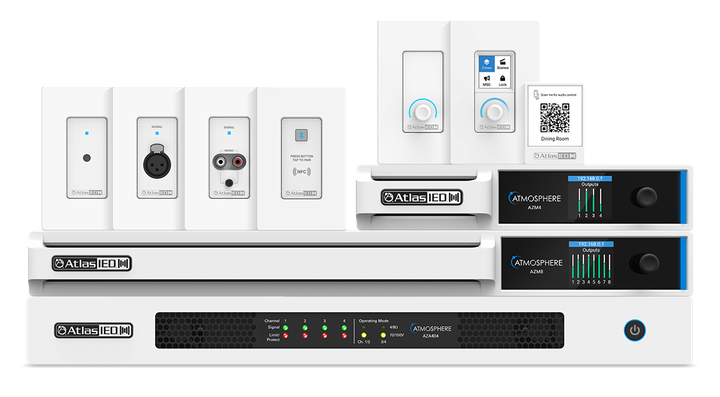 At press time AtlasIED Version 2.0 firmware for the company’s Atmosphere Digital Audio System debuted with enhanced customization of music delivery, support of bell scheduling, and streamlined post-installation service. The updated version enables several performance and installation enhancements, including stereo and subwoofer support, self-healing accessories, room combine, and bell scheduling. These and other updates offer integrators even greater opportunities to customize the delivery and control of audio to satisfy the unique requirements of restaurants, bars, hotels, school campuses, houses of worship, retail establishments, and other commercial environments. The new Atmosphere software supports the system’s original core technologies, such as touchless control and artificial intelligence, and utilizes the same product suite or digital audio processors, amplifiers, and graphical user interfaces.
At press time AtlasIED Version 2.0 firmware for the company’s Atmosphere Digital Audio System debuted with enhanced customization of music delivery, support of bell scheduling, and streamlined post-installation service. The updated version enables several performance and installation enhancements, including stereo and subwoofer support, self-healing accessories, room combine, and bell scheduling. These and other updates offer integrators even greater opportunities to customize the delivery and control of audio to satisfy the unique requirements of restaurants, bars, hotels, school campuses, houses of worship, retail establishments, and other commercial environments. The new Atmosphere software supports the system’s original core technologies, such as touchless control and artificial intelligence, and utilizes the same product suite or digital audio processors, amplifiers, and graphical user interfaces.
 The Audio-Technica ATDM-0604 is a sixchannel automatic mixer ideal for meetings, conferences, courtroom proceedings, and other applications involving the use of multiple microphones or other media inputs. AudioTechnica’s SmartMixer technology allows channels to be mixed automatically in gate or gain sharing mode, ensuring consistent, highquality audio output from all inputs in a setup. Controls and LED indicators on the mixer’s front panel allow users to easily adjust input/ output and gain levels; set and recall presets; turn on/off phantom power, low-cut filter, automatic mixing and acoustic echo cancellation; change IP configuration; and more. A full complement of digital signal processing is available for inputs and outputs, including parametric EQ, compressor, limiter, and feedback control. Control and monitoring tools are accessible locally on the front panel or via the Web Remote interface, which allows users to handle the adjustments from a Windows-based PC, Mac, iOS or Android device, plus make additional changes to settings.
The Audio-Technica ATDM-0604 is a sixchannel automatic mixer ideal for meetings, conferences, courtroom proceedings, and other applications involving the use of multiple microphones or other media inputs. AudioTechnica’s SmartMixer technology allows channels to be mixed automatically in gate or gain sharing mode, ensuring consistent, highquality audio output from all inputs in a setup. Controls and LED indicators on the mixer’s front panel allow users to easily adjust input/ output and gain levels; set and recall presets; turn on/off phantom power, low-cut filter, automatic mixing and acoustic echo cancellation; change IP configuration; and more. A full complement of digital signal processing is available for inputs and outputs, including parametric EQ, compressor, limiter, and feedback control. Control and monitoring tools are accessible locally on the front panel or via the Web Remote interface, which allows users to handle the adjustments from a Windows-based PC, Mac, iOS or Android device, plus make additional changes to settings.
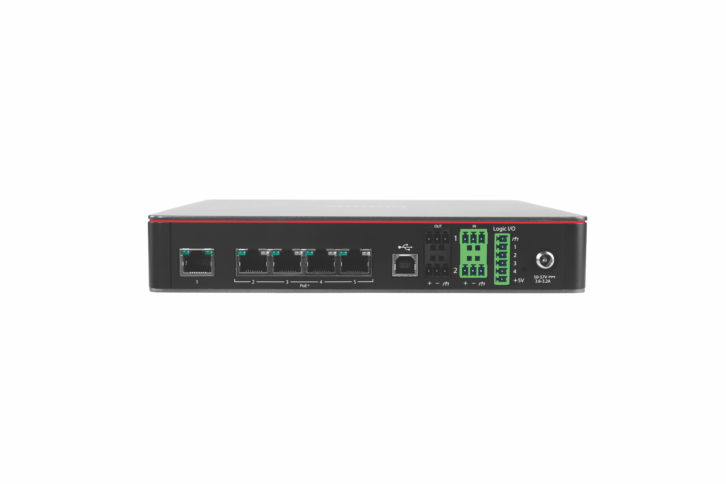 In January, Biamp TesiraFORTÉ X Series debuted. It is a range of premium open-architecture meeting room processors designed to accommodate demanding conferencing applications in which customization is essential. The TesiraFORTÉ X Series combines the advanced signal processing of the original TesiraFORTÉ system with streamlined network connectivity and a uniquely small industrial design, simplifying meeting room deployments by providing all the connectivity and processing required in a single device. TesiraFORTÉ X also offers fast and simple setup with Biamp Launch, Biamp’s onetouch automatic device discovery and tuning feature, accessible at the press of a button. Installers connect all the devices for their room and press the Launch button for a fully automated setup experience. By automating the room tuning and commissioning process, Biamp Launch guarantees consistently great audio in any space with remarkable speed, according to to the company. Alternatively, installers can program the TesiraFORTÉ X Series in the traditional way with all the customization and flexibility they would expect from Tesira. Each unit is compact enough to be installed anywhere and includes mounting hardware ideal for installation on a wall or behind a display. TesiraFORTÉ X Series supports both Dante and AVB out of the box, making integration with other AV components simple and flexible. There are three models in the TesiraFORTÉ X Series—the X 400, X 800, and X 1600—with four, eight, and 16 channels of AEC (acoustic echo cancellation), respectively, enough for up to 16 Biamp Parlé Beamtracking microphones.
In January, Biamp TesiraFORTÉ X Series debuted. It is a range of premium open-architecture meeting room processors designed to accommodate demanding conferencing applications in which customization is essential. The TesiraFORTÉ X Series combines the advanced signal processing of the original TesiraFORTÉ system with streamlined network connectivity and a uniquely small industrial design, simplifying meeting room deployments by providing all the connectivity and processing required in a single device. TesiraFORTÉ X also offers fast and simple setup with Biamp Launch, Biamp’s onetouch automatic device discovery and tuning feature, accessible at the press of a button. Installers connect all the devices for their room and press the Launch button for a fully automated setup experience. By automating the room tuning and commissioning process, Biamp Launch guarantees consistently great audio in any space with remarkable speed, according to to the company. Alternatively, installers can program the TesiraFORTÉ X Series in the traditional way with all the customization and flexibility they would expect from Tesira. Each unit is compact enough to be installed anywhere and includes mounting hardware ideal for installation on a wall or behind a display. TesiraFORTÉ X Series supports both Dante and AVB out of the box, making integration with other AV components simple and flexible. There are three models in the TesiraFORTÉ X Series—the X 400, X 800, and X 1600—with four, eight, and 16 channels of AEC (acoustic echo cancellation), respectively, enough for up to 16 Biamp Parlé Beamtracking microphones.
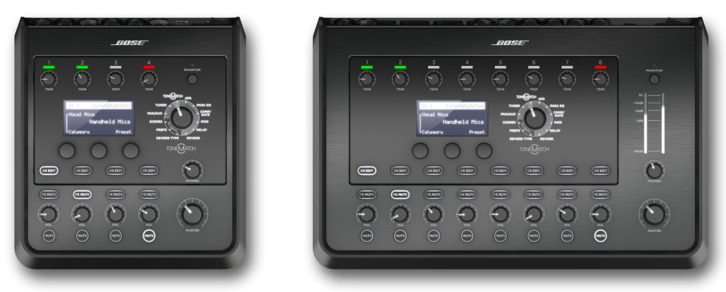 The latest additions to Bose’s ToneMatch audio engine series, the eight-channel Bose T8S ToneMatch mixer and the four-channel Bose T4S ToneMatch mixer, are compact and portable. Their enclosures have a protective, magnetically-coupled cover to protect controls and connectors. A chassis bottom insert allows the use of standard mounting accessories to keep the mixers in reach during performances. The T8S is intuitive to operate, with illuminated, stage friendly tactile controls, an easy-to-read display, and scene recall. ToneMatch processing provides presets with the DSP engine, including effects and Bose zEQ equalization. The T4S offers most of the same features as the T8S, but also includes dual ToneMatch links, designed to send digital audio to L1 Model 1S/ II systems while receiving power on the same provided ToneMatch cable. Last fall, the company debuted a carrying case for the T4S and T8S ToneMatch mixers compatible with the T4S and T8S ToneMatch mixers. Each case features an integrated storage compartment, with the ability to carry the power supply, ToneMatch cable and additional equipment.
The latest additions to Bose’s ToneMatch audio engine series, the eight-channel Bose T8S ToneMatch mixer and the four-channel Bose T4S ToneMatch mixer, are compact and portable. Their enclosures have a protective, magnetically-coupled cover to protect controls and connectors. A chassis bottom insert allows the use of standard mounting accessories to keep the mixers in reach during performances. The T8S is intuitive to operate, with illuminated, stage friendly tactile controls, an easy-to-read display, and scene recall. ToneMatch processing provides presets with the DSP engine, including effects and Bose zEQ equalization. The T4S offers most of the same features as the T8S, but also includes dual ToneMatch links, designed to send digital audio to L1 Model 1S/ II systems while receiving power on the same provided ToneMatch cable. Last fall, the company debuted a carrying case for the T4S and T8S ToneMatch mixers compatible with the T4S and T8S ToneMatch mixers. Each case features an integrated storage compartment, with the ability to carry the power supply, ToneMatch cable and additional equipment.
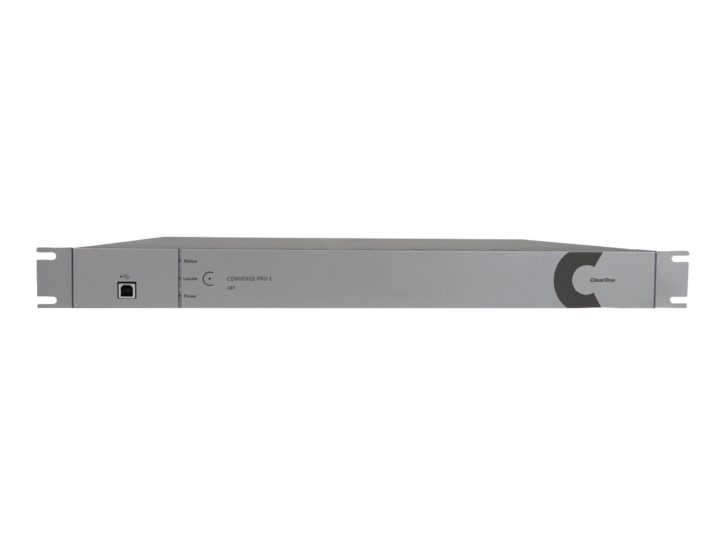 The ClearOne CONVERGE Pro 2 48VTD mixer includes VoIP, Telco, and Dante interfaces in a single unit. The 48VTD pairs well with ClearOne’s P-Link-based BMA CT, allowing integrators to bring a low-cost Dante interface to the BMA CT. It functions the same as ClearOne’s existing V and T offerings providing a 10-Watt amplifier, four configurable mic/line audio inputs, and 8 configurable mic/ line outputs. Additionally, all models are Avaya, Cisco, and ShoreTel compliant, and support built-in USB audio, and built-in Skype for Business along with interfaces for VoIP, Telco, and Dante. The VTD series works with all existing CONVERGE Pro 2 units and all existing P-Link peripheral products.
The ClearOne CONVERGE Pro 2 48VTD mixer includes VoIP, Telco, and Dante interfaces in a single unit. The 48VTD pairs well with ClearOne’s P-Link-based BMA CT, allowing integrators to bring a low-cost Dante interface to the BMA CT. It functions the same as ClearOne’s existing V and T offerings providing a 10-Watt amplifier, four configurable mic/line audio inputs, and 8 configurable mic/ line outputs. Additionally, all models are Avaya, Cisco, and ShoreTel compliant, and support built-in USB audio, and built-in Skype for Business along with interfaces for VoIP, Telco, and Dante. The VTD series works with all existing CONVERGE Pro 2 units and all existing P-Link peripheral products.
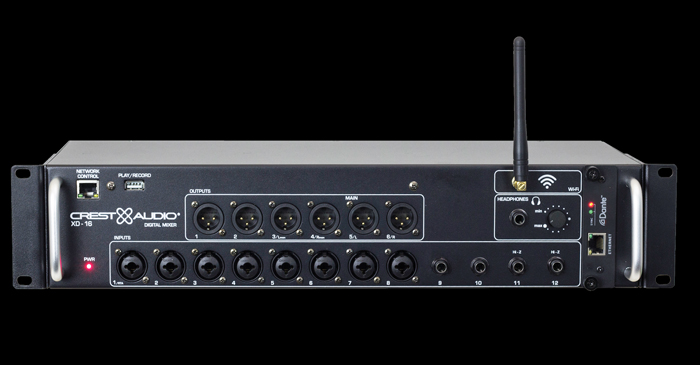 The Crest Audio XD-16 and XD-28 digital mixers are small format, 2U rackmount mixers available in either 16- or 28-channel frames. XD Series digital mixers offer optional Dante networking as well as a realtime remote control and monitoring from any Android, Windows, or iOS device. The range of configurations available enables use as a simple FoH mixer, a monitor mixer, a personal monitor mixer, or a combination of all three. An integrated WiFi module enables real-time control and monitoring of the mixer processing functions, either by acting as a WiFi router for direct connection of up to four external devices for remote control, or alternatively by connecting to an external WiFi network. The optional 4×4 Dante network module allows up to eight channels (4-in/4-out) of audio streaming over a Dante network, and also extends the physical inputs of the XD-16/XD-28 by four aux channels, and also adds four outputs. Control is provided via the Dante Controller application.
The Crest Audio XD-16 and XD-28 digital mixers are small format, 2U rackmount mixers available in either 16- or 28-channel frames. XD Series digital mixers offer optional Dante networking as well as a realtime remote control and monitoring from any Android, Windows, or iOS device. The range of configurations available enables use as a simple FoH mixer, a monitor mixer, a personal monitor mixer, or a combination of all three. An integrated WiFi module enables real-time control and monitoring of the mixer processing functions, either by acting as a WiFi router for direct connection of up to four external devices for remote control, or alternatively by connecting to an external WiFi network. The optional 4×4 Dante network module allows up to eight channels (4-in/4-out) of audio streaming over a Dante network, and also extends the physical inputs of the XD-16/XD-28 by four aux channels, and also adds four outputs. Control is provided via the Dante Controller application.
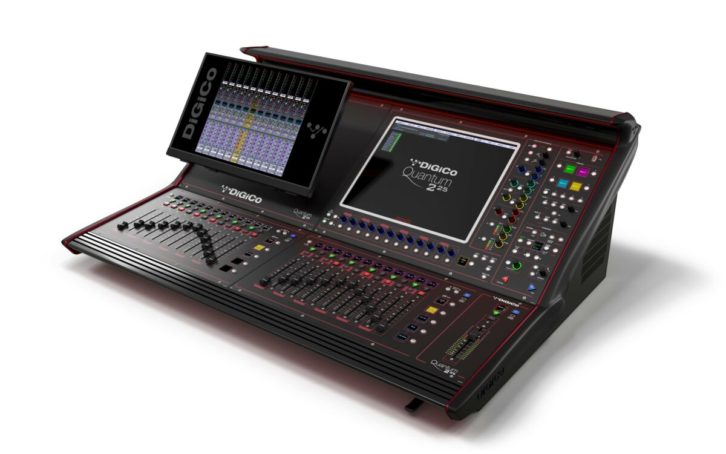 In February, the DiGiCo Quantum 225 joined the Quantum lineup as a value console. DiGiCo has designed the Quantum225 to be adaptable to the demands of our changing Covid-impacted world. When specified with the new DQ-Rack with integrated Dante suits an AV installation/AoIP networking environment. Alternatively specified with the MQ-Rack nets the familiar MADI connectivity for touring, allowing Quantum225 to integrate with existing infrastructure. The Quantum225 includes 72 input channels with 36 busses + Master Buss and a 12×12 Matrix. There are four MADI ports and dual DMI ports for added connectivity, 8×8 analog and four AES channels for local I/O, built-in UB MADI, optional optics and Waves SoundGrid, plus dual PSU. The Quantum225 also incorporates the Mustard Processing channel strips, Spice Rack plugin style native FPGA processing options, Nodal Processing and True Solo. The console has the 338’s 17-inch, full-color, daylight-bright TFT multi-touch screen with the Quantum Dark application, combined with 41 mini TFT’s located across the surface. A custom-designed, multipurpose mounting bracket can accommodate an additional channel or overview screen, a KLANG:kontroller, or be further expanded to fit either a laptop or a run script.
In February, the DiGiCo Quantum 225 joined the Quantum lineup as a value console. DiGiCo has designed the Quantum225 to be adaptable to the demands of our changing Covid-impacted world. When specified with the new DQ-Rack with integrated Dante suits an AV installation/AoIP networking environment. Alternatively specified with the MQ-Rack nets the familiar MADI connectivity for touring, allowing Quantum225 to integrate with existing infrastructure. The Quantum225 includes 72 input channels with 36 busses + Master Buss and a 12×12 Matrix. There are four MADI ports and dual DMI ports for added connectivity, 8×8 analog and four AES channels for local I/O, built-in UB MADI, optional optics and Waves SoundGrid, plus dual PSU. The Quantum225 also incorporates the Mustard Processing channel strips, Spice Rack plugin style native FPGA processing options, Nodal Processing and True Solo. The console has the 338’s 17-inch, full-color, daylight-bright TFT multi-touch screen with the Quantum Dark application, combined with 41 mini TFT’s located across the surface. A custom-designed, multipurpose mounting bracket can accommodate an additional channel or overview screen, a KLANG:kontroller, or be further expanded to fit either a laptop or a run script.
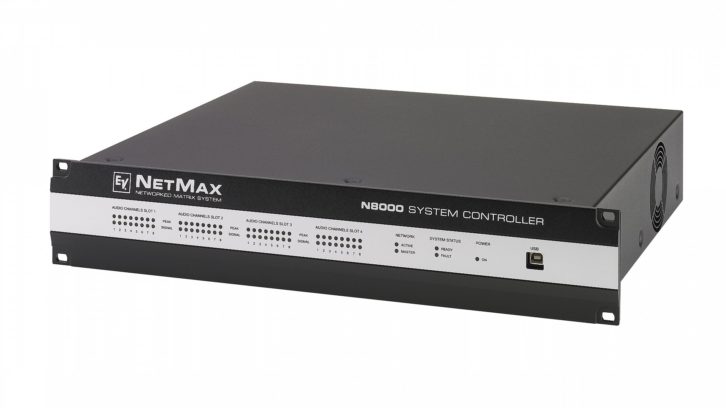 The Electro-Voice N8000 NetMax 300 MIPS digital matrix controller delivers full IRISNet supervision, control, and scheduling along with up to 32 input channels, extensive DSP, and CobraNet audio and control connections. It offers support for Ethernet, RS-232, USB, and CAN, and Dante audio networking options are available. Four slots with 8-channel audio modules form the foundation for flexible customization, and each slot can house input or output cards. It includes internal 48-bit processing, and the auto-compiling DSP engine has ultra-low fixed latency. One time or regularly scheduled events can be arranged and reactions to certain events or system states can be configured. Any system problems can be detected automatically and can be displayed on the PC screen or transmitted to external sites.
The Electro-Voice N8000 NetMax 300 MIPS digital matrix controller delivers full IRISNet supervision, control, and scheduling along with up to 32 input channels, extensive DSP, and CobraNet audio and control connections. It offers support for Ethernet, RS-232, USB, and CAN, and Dante audio networking options are available. Four slots with 8-channel audio modules form the foundation for flexible customization, and each slot can house input or output cards. It includes internal 48-bit processing, and the auto-compiling DSP engine has ultra-low fixed latency. One time or regularly scheduled events can be arranged and reactions to certain events or system states can be configured. Any system problems can be detected automatically and can be displayed on the PC screen or transmitted to external sites.
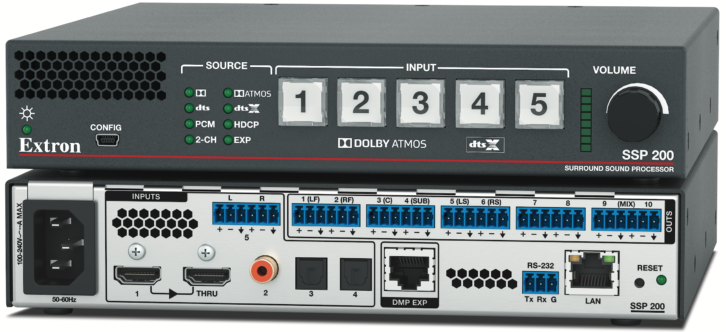 In April, Extron began shipping the Extron SSP 200 high-performance Surround Sound Processor designed for pro AV applications in corporate and commercial environments. This new processor automatically decodes Dolby and DTS formats from HDMI sources to discrete audio outputs. Providing up to 10 builtin outputs, plus additional outputs via an EXP port, the SSP 200 provides the flexibility needed for multimedia system requirements, including support for the latest immersive formats of Dolby Atmos and DTS:X. An up-mix function synthesizes exceptional multichannel audio from stereo content.
In April, Extron began shipping the Extron SSP 200 high-performance Surround Sound Processor designed for pro AV applications in corporate and commercial environments. This new processor automatically decodes Dolby and DTS formats from HDMI sources to discrete audio outputs. Providing up to 10 builtin outputs, plus additional outputs via an EXP port, the SSP 200 provides the flexibility needed for multimedia system requirements, including support for the latest immersive formats of Dolby Atmos and DTS:X. An up-mix function synthesizes exceptional multichannel audio from stereo content.
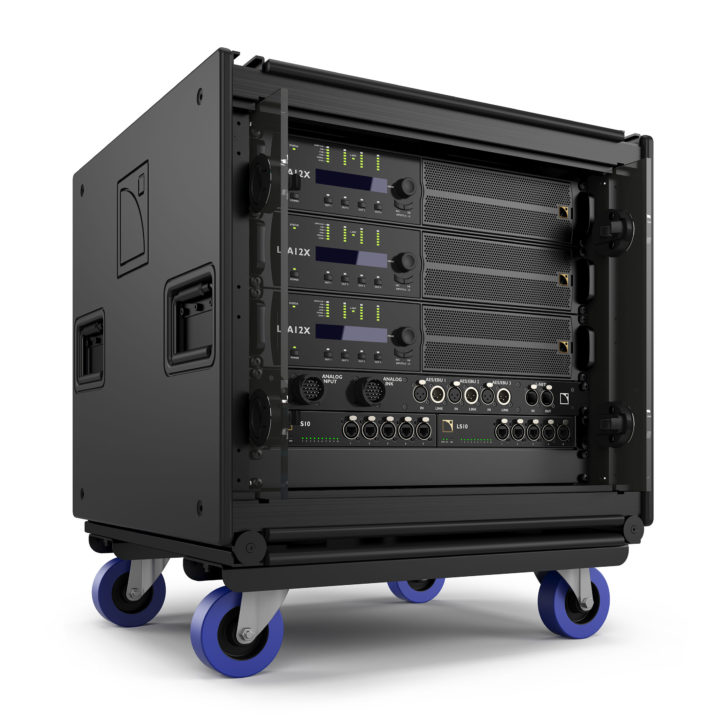 The L-Acoustics LA-RAK II AVB flyable touring rack comprises twelve channels of amplification in a 9U frame. Also included are three Milan-certified LA12X amplified controllers, two LS10 AVB switches, and power and signal distribution panels that are internally prewired to offer a plug-and-play, reliable and redundant networked audio. Two LS10 AVB switches in a 1U space within the rack allow for seamless dual network redundancy and a full AVB ecosystem from the P1 processor at FOH down to the Milan-certified amplified controllers. If any failure occurs on the primary audio network, the redundant AVB network automatically switches over with zero audio loss. Up to eight channels in one AVB stream can be passed over a single cable. As with its predecessors, LA-RAK II AVB is rugged, featuring a shock-absorbing inner frame, protective, and handling elements to facilitate transport. Compatible with any voltage standard, LARAK II AVB functions worldwide and facilitates tour logistics and cross-rental among L-Acoustics rental partners. LARAK II AVB is mechanically and electronically compatible with the legacy LA-RAK II and LA-RAK standards. An LARAK II AVB upgrade kit will be available for existing LARAK II owners for upgrade to AVB.
The L-Acoustics LA-RAK II AVB flyable touring rack comprises twelve channels of amplification in a 9U frame. Also included are three Milan-certified LA12X amplified controllers, two LS10 AVB switches, and power and signal distribution panels that are internally prewired to offer a plug-and-play, reliable and redundant networked audio. Two LS10 AVB switches in a 1U space within the rack allow for seamless dual network redundancy and a full AVB ecosystem from the P1 processor at FOH down to the Milan-certified amplified controllers. If any failure occurs on the primary audio network, the redundant AVB network automatically switches over with zero audio loss. Up to eight channels in one AVB stream can be passed over a single cable. As with its predecessors, LA-RAK II AVB is rugged, featuring a shock-absorbing inner frame, protective, and handling elements to facilitate transport. Compatible with any voltage standard, LARAK II AVB functions worldwide and facilitates tour logistics and cross-rental among L-Acoustics rental partners. LARAK II AVB is mechanically and electronically compatible with the legacy LA-RAK II and LA-RAK standards. An LARAK II AVB upgrade kit will be available for existing LARAK II owners for upgrade to AVB.
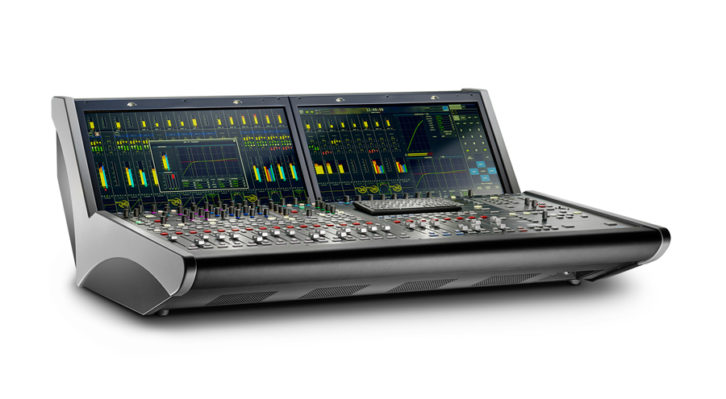 The Lawo mc²36 is natively equipped with RAVENNA/AES67 to integrate into IP infrastructure. With an internal 512×512 port audio matrix and integrated IO, it was designed to be a truly “universal” console, with its focus on space efficiency and ease-of-use. Its 21.5- inch full HD touchscreens work with touchsensitive color-illuminated rotary encoders to provide intuitive operation. In terms of connectivity, the console’s interfaces include 32 mic/line inputs, 32 line outputs, eight digital AES3 inputs, eight digital AES3 outputs, eight GPIO ports, one MADI (SFP) port, three RAVENNA/AES67 channels, and a headphone jack. In addition to the onboard I/O, a MADI tie-line connection and three RAVENNA/ AES67 Audioover-IP ports provide futureproof connectivity for up to 384 external inputs and outputs, offering a total capacity of 496 physical inputs and outputs. It can ship pre-configured or custom-configured.
The Lawo mc²36 is natively equipped with RAVENNA/AES67 to integrate into IP infrastructure. With an internal 512×512 port audio matrix and integrated IO, it was designed to be a truly “universal” console, with its focus on space efficiency and ease-of-use. Its 21.5- inch full HD touchscreens work with touchsensitive color-illuminated rotary encoders to provide intuitive operation. In terms of connectivity, the console’s interfaces include 32 mic/line inputs, 32 line outputs, eight digital AES3 inputs, eight digital AES3 outputs, eight GPIO ports, one MADI (SFP) port, three RAVENNA/AES67 channels, and a headphone jack. In addition to the onboard I/O, a MADI tie-line connection and three RAVENNA/ AES67 Audioover-IP ports provide futureproof connectivity for up to 384 external inputs and outputs, offering a total capacity of 496 physical inputs and outputs. It can ship pre-configured or custom-configured.
 Lectrosonics had versatility in mind when it developed the Lectrosonics Aspen SPN2412, with its 24 inputs and 12 outputs, which can be expanded to many more. The Proportional Gain Algorithm allows it to work seamlessly with other sound gear, while data, audio, and control signals are carried through a single Cat-6 cable. Setup is aided by automatic master/slave detection and its automatic mixing parameters and presets are extensive including multizone mix minus configuration. The Phantom Mix mode lets the mixing come from multiple zones and fed back into only those zones that are selected for the feed. And with TCP/IP addressability for control through Ethernet, it can be part of your network.
Lectrosonics had versatility in mind when it developed the Lectrosonics Aspen SPN2412, with its 24 inputs and 12 outputs, which can be expanded to many more. The Proportional Gain Algorithm allows it to work seamlessly with other sound gear, while data, audio, and control signals are carried through a single Cat-6 cable. Setup is aided by automatic master/slave detection and its automatic mixing parameters and presets are extensive including multizone mix minus configuration. The Phantom Mix mode lets the mixing come from multiple zones and fed back into only those zones that are selected for the feed. And with TCP/IP addressability for control through Ethernet, it can be part of your network.
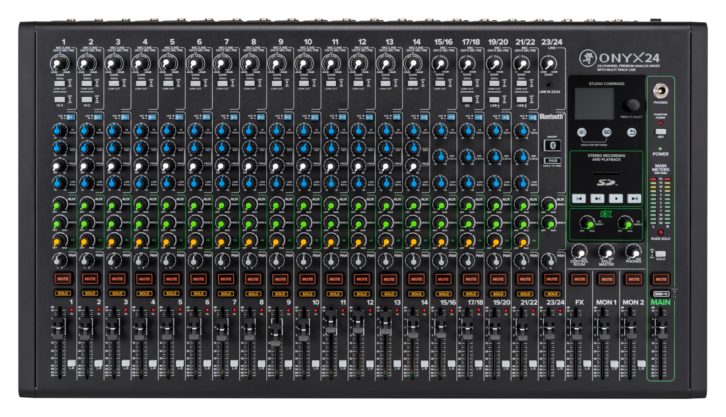 In January the new Mackie Onyx analog range came onstream—users can now choose among Onyx 8, Onyx 12, Onyx 16 and Onyx 24. Key new features include the ability to record a multi-track session via USB at 24-bit/96kHz, record a stereo mix of a live show to an SD card, the high-gain Onyx mic preamps and the Perkins “British Style” EQ. It’s got the Mackie “Built Like a Tank” thing going on too. Bundles with Pro Tools first and Mackie Musician Collection plugins.
In January the new Mackie Onyx analog range came onstream—users can now choose among Onyx 8, Onyx 12, Onyx 16 and Onyx 24. Key new features include the ability to record a multi-track session via USB at 24-bit/96kHz, record a stereo mix of a live show to an SD card, the high-gain Onyx mic preamps and the Perkins “British Style” EQ. It’s got the Mackie “Built Like a Tank” thing going on too. Bundles with Pro Tools first and Mackie Musician Collection plugins.
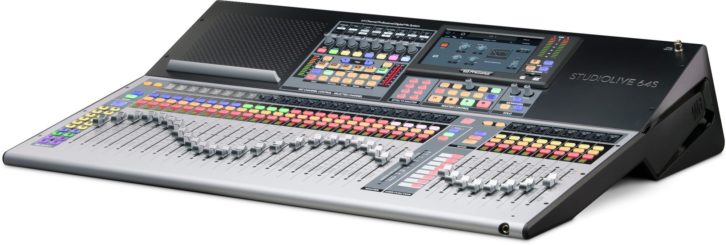 The PreSonus StudioLive 64S is the flagship mixer of the StudioLive Series III S line of mixers that elevate live sound production, touring, high channel count performances, installed sound, mobile, and studio applications. Powered by the PreSonus FLEX DSP Engine, they feature state-space modeled Fat Channel plug-in processing on every input and bus; up to 32 FlexMix buses that can be individually configured as Aux, Matrix, or Subgroup buses; and flexible digital patching unparalleled in this price class. All models deliver 128-channel (64×64) USB recording—more than any other mixer—plus multitrack SD recording and extensive 128-channel AVB networking. The StudioLive 64S brings the power of a large production console to smallformat digital mixing, with 76 mixing channels, 43 buses, and 526 simultaneous effects thanks to the quad-core FLEX DSP engine. StudioLive 64S mixers feature an independent main Mono/Center bus; each channel has a dedicated level control and a Center Divergence control that allows you to control the pan placement in your LCR mix.
The PreSonus StudioLive 64S is the flagship mixer of the StudioLive Series III S line of mixers that elevate live sound production, touring, high channel count performances, installed sound, mobile, and studio applications. Powered by the PreSonus FLEX DSP Engine, they feature state-space modeled Fat Channel plug-in processing on every input and bus; up to 32 FlexMix buses that can be individually configured as Aux, Matrix, or Subgroup buses; and flexible digital patching unparalleled in this price class. All models deliver 128-channel (64×64) USB recording—more than any other mixer—plus multitrack SD recording and extensive 128-channel AVB networking. The StudioLive 64S brings the power of a large production console to smallformat digital mixing, with 76 mixing channels, 43 buses, and 526 simultaneous effects thanks to the quad-core FLEX DSP engine. StudioLive 64S mixers feature an independent main Mono/Center bus; each channel has a dedicated level control and a Center Divergence control that allows you to control the pan placement in your LCR mix.
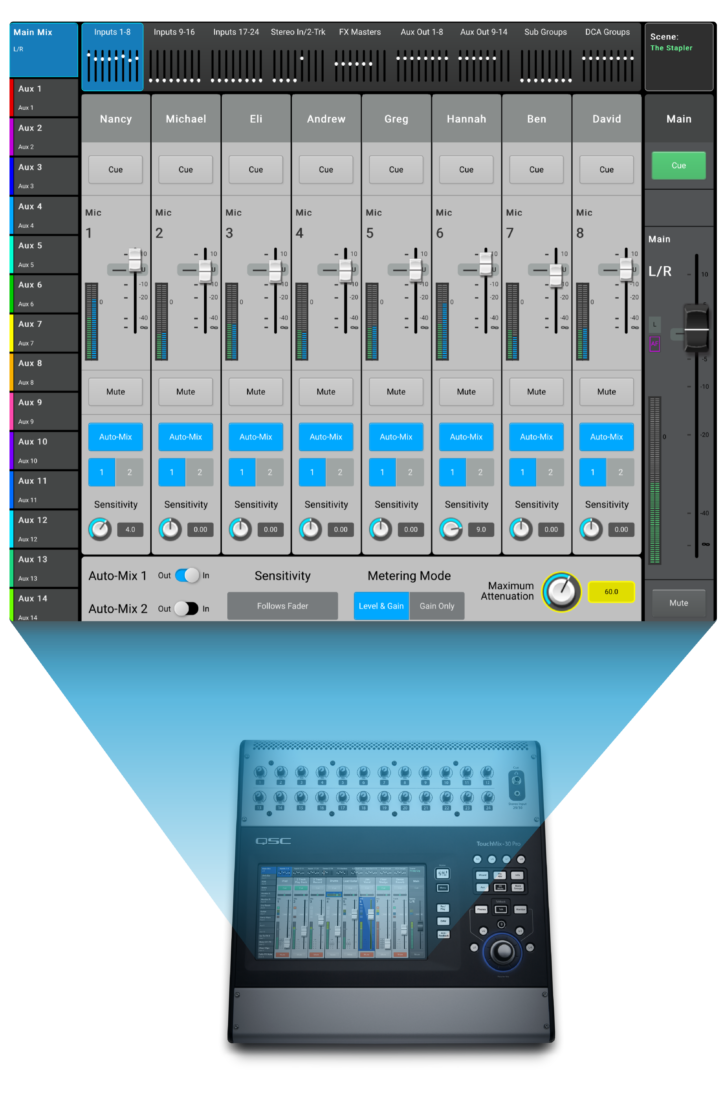 QSC TouchMix is a powerful, small-format digital mixer series. From the highly compact TouchMix-8 to the flagship TouchMix-30 Pro, the TouchMix Series was designed to build large-format consoles features into a refined and portable package that’s small enough to be carry-on luggage. Perfect for musicians, bands, AV production professionals and small performance venues, TouchMix goes “Beyond Mixing” by also offering Wizards, Presets and other beneficial tools that help both seasoned audio professionals and novices alike get great results quickly and easily.
QSC TouchMix is a powerful, small-format digital mixer series. From the highly compact TouchMix-8 to the flagship TouchMix-30 Pro, the TouchMix Series was designed to build large-format consoles features into a refined and portable package that’s small enough to be carry-on luggage. Perfect for musicians, bands, AV production professionals and small performance venues, TouchMix goes “Beyond Mixing” by also offering Wizards, Presets and other beneficial tools that help both seasoned audio professionals and novices alike get great results quickly and easily.
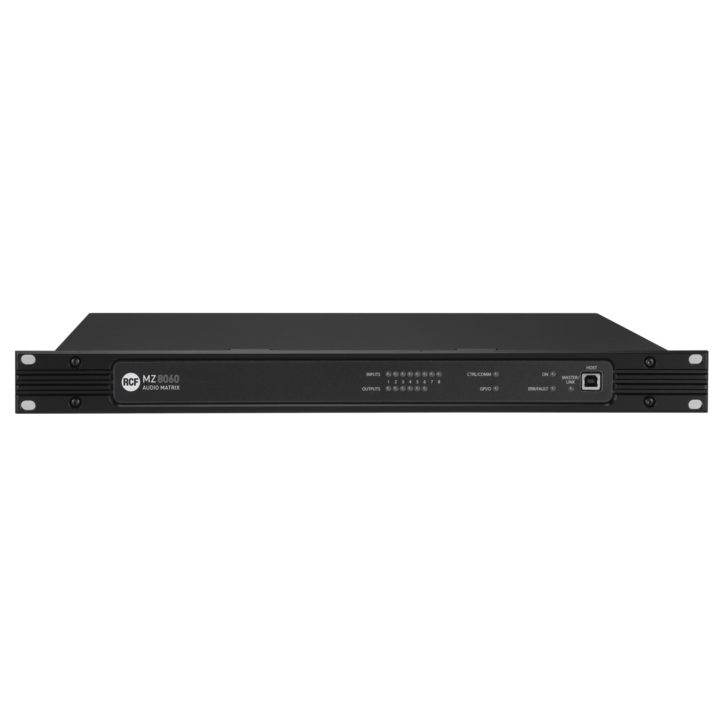 The RCF MZ 8060 is a versatile 8×6 digital audio matrix mixer built on the foundation of RCF’s RDNet DSP platform. RDNet is a proprietary protocol for RCF loudspeaker products that provides dedicated networking software that makes is possible to control and monitor all system components and parameters. The DSP allows for configurable system programming including room combining, automatic level control, along with all audio input and output criteria including EQs, gates, compressors, limiters, delays, priorities, and levels. The MX8060 features eight universal mic/ line inputs with six balanced outputs along with 10 programmable logic inputs and six programmable logic outputs. It features eight universal mic/ line inputs with 48V phantom power and full audio processing, six hi-level routable balanced outputs with full audio processing, 10 programmable logic inputs (GPI), and six programmable logic outputs (GPO).
The RCF MZ 8060 is a versatile 8×6 digital audio matrix mixer built on the foundation of RCF’s RDNet DSP platform. RDNet is a proprietary protocol for RCF loudspeaker products that provides dedicated networking software that makes is possible to control and monitor all system components and parameters. The DSP allows for configurable system programming including room combining, automatic level control, along with all audio input and output criteria including EQs, gates, compressors, limiters, delays, priorities, and levels. The MX8060 features eight universal mic/ line inputs with six balanced outputs along with 10 programmable logic inputs and six programmable logic outputs. It features eight universal mic/ line inputs with 48V phantom power and full audio processing, six hi-level routable balanced outputs with full audio processing, 10 programmable logic inputs (GPI), and six programmable logic outputs (GPO).
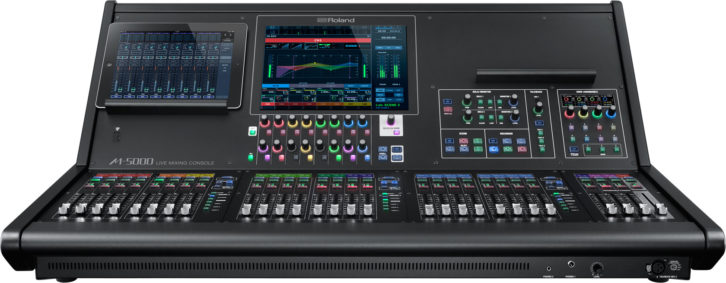 The Roland M-5000 Series apply its OHRCA (Open High Resolution Configurable Architecture) to provide 128 freely definable audio paths. The mixers have expansion modules for Dante, MADI, Waves Soundgrid, REAC, XI-SDI, XISFP, and XI-DVI. Its patchbays can accommodate hundreds of input/output channels enabling any input to be routed to a range of outputs without using a mixing channel. The M-5000 has 24 plus 4 faders while the slightly smaller M-5000C uses 16 plus 4 faders. The operation is focused on a bright 12in. touchscreen with 16 encoders having rings that change color according to their assigned functions.
The Roland M-5000 Series apply its OHRCA (Open High Resolution Configurable Architecture) to provide 128 freely definable audio paths. The mixers have expansion modules for Dante, MADI, Waves Soundgrid, REAC, XI-SDI, XISFP, and XI-DVI. Its patchbays can accommodate hundreds of input/output channels enabling any input to be routed to a range of outputs without using a mixing channel. The M-5000 has 24 plus 4 faders while the slightly smaller M-5000C uses 16 plus 4 faders. The operation is focused on a bright 12in. touchscreen with 16 encoders having rings that change color according to their assigned functions.
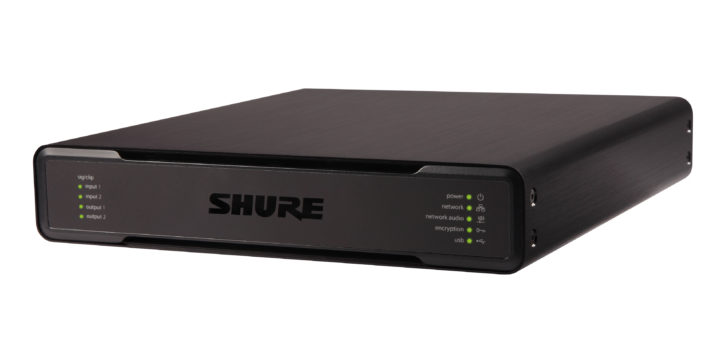 The Shure IntelliMix P300 conferencing connects up to 10 Dante audio inputs, two analog inputs, a USB soft codec, and mobile device. Each input channel can be auto-mixed and provides acoustic echo cancellation, noise reduction, automatic gain control, matrix mixing, delay, compressor, and PEQ. An additional 3.5mm connection enables attendees to join by tablet or phone, and all this fits into a half-rack space package. It connects to room systems through two input and two output terminal blocks while its Ethernet connection can use PoE to eliminate a separate power supply. Additionally, a predefined matrix and presets can simplify the setup process.
The Shure IntelliMix P300 conferencing connects up to 10 Dante audio inputs, two analog inputs, a USB soft codec, and mobile device. Each input channel can be auto-mixed and provides acoustic echo cancellation, noise reduction, automatic gain control, matrix mixing, delay, compressor, and PEQ. An additional 3.5mm connection enables attendees to join by tablet or phone, and all this fits into a half-rack space package. It connects to room systems through two input and two output terminal blocks while its Ethernet connection can use PoE to eliminate a separate power supply. Additionally, a predefined matrix and presets can simplify the setup process.
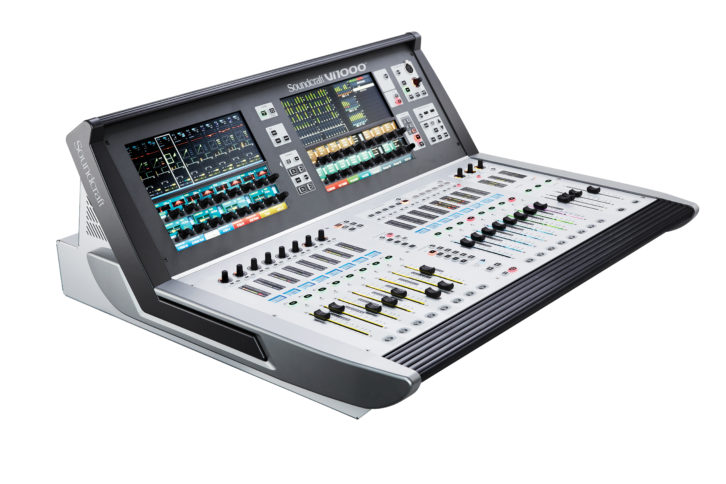
The Soundcraft by HARMAN Vi1000 is a 34in. x 32in. compliment to its two larger siblings, the Vi2000 and 3000. The Vi1000 employs Soundcraft’s Vistonics II channel strip user interface, as well as SpiderCore, a built-in DSP and I/O engine based on STUDER technology, offering 40-bit floating point processing. The Vi1000 features an additional remote-control surface for any of the larger consoles in the range, using their Mirroring feature. The Vi1000 comes with rear panel local I/O featuring 16 HQ mic/line inputs, 16 line outputs, and two 64-channel expansion slots that allow up to two MADIbased Stageboxes to be connected, or alternatively the slots provide access to an extensive range of D21m I/O option cards, that address all industry standard audio formats. Four channels of AES/EBU I/O plus USB and MIDI connections complete the back panel. The total I/O count of the console is 212 in x 212 out.
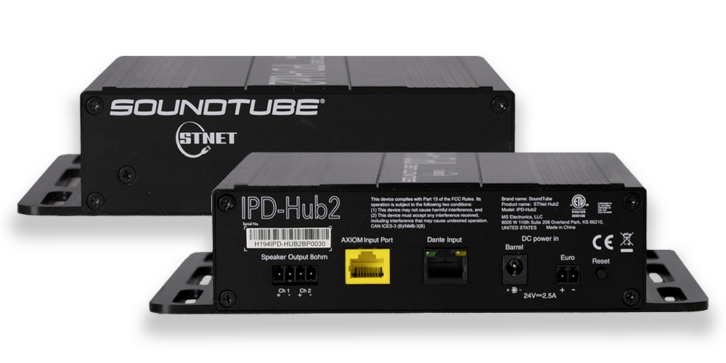 The SoundTube IPD Hub 2 amplifier from MSE Audio is a two-channel Dante amp with DSP built-in, designed for small- to mediumsized applications. The amp is AES67-compatible and powered by PoE, PoE+ or 40W PoE. It includes an RJ45 Ethernet connection and can be used with Radio Design Labs Format A (RDL) or Attero Tech Axiom line level, mic level, balanced XLR or Bluetooth input devices — stereo or mono, virtually any input. Integrators can create a complete Dante-enabled audio system with SoundTube RVC-1 controls without using a traditional DSP. Using a decentralized DSP amplifier in each zone rather than a centralized DSP greatly reduces hardware costs making an IPD-HUB 2 networked audio system about the same price as a conventional 70/100V distributed audio system. The IPD HUB 2 Amplifier can be linked together to distribute audio over large spaces or set up to operate in up to eight zones.
The SoundTube IPD Hub 2 amplifier from MSE Audio is a two-channel Dante amp with DSP built-in, designed for small- to mediumsized applications. The amp is AES67-compatible and powered by PoE, PoE+ or 40W PoE. It includes an RJ45 Ethernet connection and can be used with Radio Design Labs Format A (RDL) or Attero Tech Axiom line level, mic level, balanced XLR or Bluetooth input devices — stereo or mono, virtually any input. Integrators can create a complete Dante-enabled audio system with SoundTube RVC-1 controls without using a traditional DSP. Using a decentralized DSP amplifier in each zone rather than a centralized DSP greatly reduces hardware costs making an IPD-HUB 2 networked audio system about the same price as a conventional 70/100V distributed audio system. The IPD HUB 2 Amplifier can be linked together to distribute audio over large spaces or set up to operate in up to eight zones.
 The SSL Live Consoles include the L100, L200, L350 and L550. They are designed for demanding applications in Touring, Installation, Houses Of Worship and Theatre. The design prioritized placing the most commonly used functions so that they sit within reach where the users hands naturally fall on the console with a combination of gestural touchscreen and hardware control. There is a lot of visual feedback with and carefully thought out color change technology that will not fatigue the user during long periods of operation. The underlying technology is Tempest, a ground-up fourth-generation digital audio platform developed specifically to meet the requirements of the live environment. All legacy code – the key to the sonic excellence of previous generations of SSL digital consoles – has been rewritten in the latest software languages. The high-capacity signal processing engine at the heart of Tempest uses SSL’s patented Optimal Core Processing (OCP). SSL Live signal processing engine is integrated entirely within the control surface
The SSL Live Consoles include the L100, L200, L350 and L550. They are designed for demanding applications in Touring, Installation, Houses Of Worship and Theatre. The design prioritized placing the most commonly used functions so that they sit within reach where the users hands naturally fall on the console with a combination of gestural touchscreen and hardware control. There is a lot of visual feedback with and carefully thought out color change technology that will not fatigue the user during long periods of operation. The underlying technology is Tempest, a ground-up fourth-generation digital audio platform developed specifically to meet the requirements of the live environment. All legacy code – the key to the sonic excellence of previous generations of SSL digital consoles – has been rewritten in the latest software languages. The high-capacity signal processing engine at the heart of Tempest uses SSL’s patented Optimal Core Processing (OCP). SSL Live signal processing engine is integrated entirely within the control surface
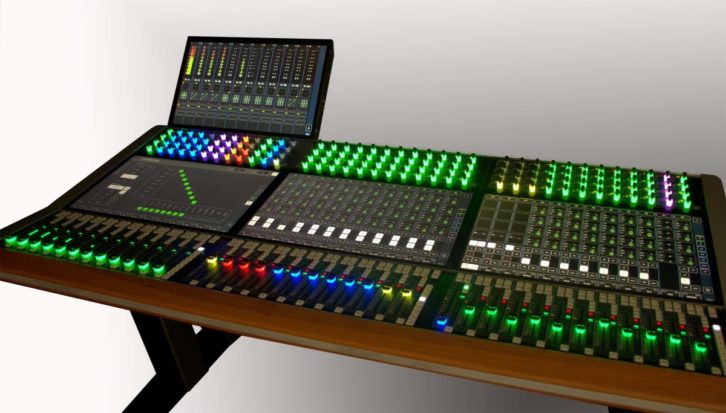 Stage Tec AVATUS is an IP-based theatre console with detachable screens. In many theaters, due to structural conditions, control rooms are built such that the sound engineers cannot see over their mixing console to the stage. AVATUS offers a solution to this problem. The theatre version of AVATUS is designed so that the upper screens are removable. Since the IP console is connected via standard TCP/IP interfaces, each module has its own IP address. This enables the screens to be installed anywhere within the NEXUS network. AVATUS IP-based connections offer new possibilities for development of infrastructures. The AVATUS audio console does not have a center section and will consist of only three different modules. The console will be available in sizes between 12 and 96 faders.
Stage Tec AVATUS is an IP-based theatre console with detachable screens. In many theaters, due to structural conditions, control rooms are built such that the sound engineers cannot see over their mixing console to the stage. AVATUS offers a solution to this problem. The theatre version of AVATUS is designed so that the upper screens are removable. Since the IP console is connected via standard TCP/IP interfaces, each module has its own IP address. This enables the screens to be installed anywhere within the NEXUS network. AVATUS IP-based connections offer new possibilities for development of infrastructures. The AVATUS audio console does not have a center section and will consist of only three different modules. The console will be available in sizes between 12 and 96 faders.
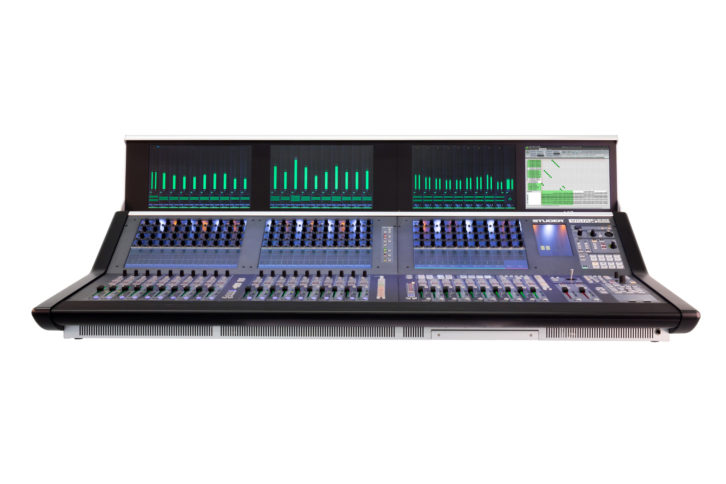 The Harman Studer Vista 5 Black Edition console is a “budget friendly” addition to its Vista 5 line. The desk is designed to be a scalable mixing system with full processing redundancy. Based on the Vista 5 M3 mixing console, the Vista 5 Black Edition features the Studer Infinity Core processing engine. The Studer Vista 5 Black Edition is available in 22-, 32-, and 44-fader sizes, and supports an optional TFT meter bridge. The console’s features include Studer’s Vistronics interface and FaderGlow technology, as well as the Infinity Core’s advanced capabilities such as Dynamic EQ plug-ins and full Core redundancy with up to 1,000 MEQs (Mono Equivalent Channels). The Vista 5 Black Edition supports any of Studer’s range of Infinity Core products, as well as the Studer Infinity Core Commercial off the Shelf (COTS) solution. This IT-based solution allows customers to run Studer’s real-time audio processing on their own server hardware by adding a standard PCIe Infinity CoreLink card.
The Harman Studer Vista 5 Black Edition console is a “budget friendly” addition to its Vista 5 line. The desk is designed to be a scalable mixing system with full processing redundancy. Based on the Vista 5 M3 mixing console, the Vista 5 Black Edition features the Studer Infinity Core processing engine. The Studer Vista 5 Black Edition is available in 22-, 32-, and 44-fader sizes, and supports an optional TFT meter bridge. The console’s features include Studer’s Vistronics interface and FaderGlow technology, as well as the Infinity Core’s advanced capabilities such as Dynamic EQ plug-ins and full Core redundancy with up to 1,000 MEQs (Mono Equivalent Channels). The Vista 5 Black Edition supports any of Studer’s range of Infinity Core products, as well as the Studer Infinity Core Commercial off the Shelf (COTS) solution. This IT-based solution allows customers to run Studer’s real-time audio processing on their own server hardware by adding a standard PCIe Infinity CoreLink card.
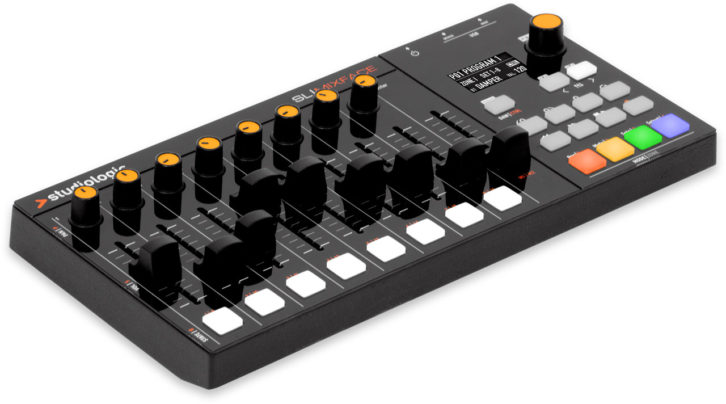 The Studiologic SL MIXFACE is a complete MIDI and DAW Controller device, fully programmable for software and hardware instruments. Designed for mobility, the unit can be battery powered or buspowered via USB. The SL MIXFACE is able to host any compatible keyboard to transform it into a full four zones MIDI controller and its connectivity ports enable it to communicate with the computer and other devices by using Bluetooth and USB simultaneously. The surface of the SL MIXFACE features nine faders, eight tracks, and one master, with dedicated, per track knobs and buttons. The usability of the controller is further enhanced by the DAW/ CTRL button, which allows users to switch the control from the DAW environment to their instrument and vice versa, all reflected on the onboard OLED screen.
The Studiologic SL MIXFACE is a complete MIDI and DAW Controller device, fully programmable for software and hardware instruments. Designed for mobility, the unit can be battery powered or buspowered via USB. The SL MIXFACE is able to host any compatible keyboard to transform it into a full four zones MIDI controller and its connectivity ports enable it to communicate with the computer and other devices by using Bluetooth and USB simultaneously. The surface of the SL MIXFACE features nine faders, eight tracks, and one master, with dedicated, per track knobs and buttons. The usability of the controller is further enhanced by the DAW/ CTRL button, which allows users to switch the control from the DAW environment to their instrument and vice versa, all reflected on the onboard OLED screen.
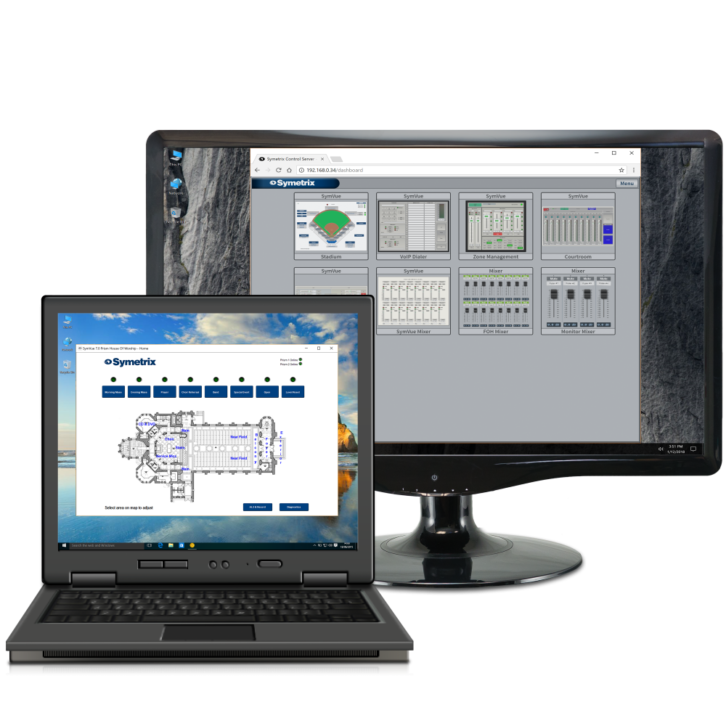 The Symetrix SymVue software, for its Control Server hardware, is a server-based application designed to control Symetrix DSPs. SymVue enables custom GUIs authored using Symetrix’ Composer running on the Symetrix Control Server hardware. Application-specific control screens can be designed and tested in minutes, without writing any code. With SymVue deployed on Symetrix Control Server hardware, Symetrix DSPs can respond to commands from any browser-enabled device — laptops, desktops, tablets, and mobile phones. SymVue’s WYSIWYG designs render in all popular web browsers and adapt to screens of different sizes, resolutions, and orientations. Parameter changes remain in sync across all networked devices including Composer, ARC Wall Panels and ARCWEB, third-party controllers, and SymVue clients on Windows PCs.
The Symetrix SymVue software, for its Control Server hardware, is a server-based application designed to control Symetrix DSPs. SymVue enables custom GUIs authored using Symetrix’ Composer running on the Symetrix Control Server hardware. Application-specific control screens can be designed and tested in minutes, without writing any code. With SymVue deployed on Symetrix Control Server hardware, Symetrix DSPs can respond to commands from any browser-enabled device — laptops, desktops, tablets, and mobile phones. SymVue’s WYSIWYG designs render in all popular web browsers and adapt to screens of different sizes, resolutions, and orientations. Parameter changes remain in sync across all networked devices including Composer, ARC Wall Panels and ARCWEB, third-party controllers, and SymVue clients on Windows PCs.
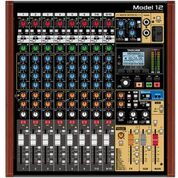 TASCAM Model 12 is a downsized counterpart to the Model 16 and 24 devices. It is a 10-input mixer with integrated 12-track digital recorder and 12-in, 10-out audio interface. There are six mono channels, each equipped with one of TASCAM’s UltraHDDA preamps, plus two stereo channels, the latter of which includes both mini-jack and Bluetooth inputs for the connection of smartphones or tablets. Each channel is equipped with a three-band EQ, low-cut filter and one-knob compressor. There is also a digital effects processor offering a range of reverb, delay and modulation effects, plus two aux outputs with individual send level controls. The Model 12 can capture 12 tracks – the ten channels plus stereo main out – in WAV format up-to 48kHz/24-bit, directly to SD, SDHC and SDXC cards. The mixer interface can also be used as a basic DAW controller too, using the MCU/HUI protocol. Additional features include MIDI in and out, a footswitch input for triggering the recorder, a stereo sub mix output, and two headphone outs with individual level controls.
TASCAM Model 12 is a downsized counterpart to the Model 16 and 24 devices. It is a 10-input mixer with integrated 12-track digital recorder and 12-in, 10-out audio interface. There are six mono channels, each equipped with one of TASCAM’s UltraHDDA preamps, plus two stereo channels, the latter of which includes both mini-jack and Bluetooth inputs for the connection of smartphones or tablets. Each channel is equipped with a three-band EQ, low-cut filter and one-knob compressor. There is also a digital effects processor offering a range of reverb, delay and modulation effects, plus two aux outputs with individual send level controls. The Model 12 can capture 12 tracks – the ten channels plus stereo main out – in WAV format up-to 48kHz/24-bit, directly to SD, SDHC and SDXC cards. The mixer interface can also be used as a basic DAW controller too, using the MCU/HUI protocol. Additional features include MIDI in and out, a footswitch input for triggering the recorder, a stereo sub mix output, and two headphone outs with individual level controls.
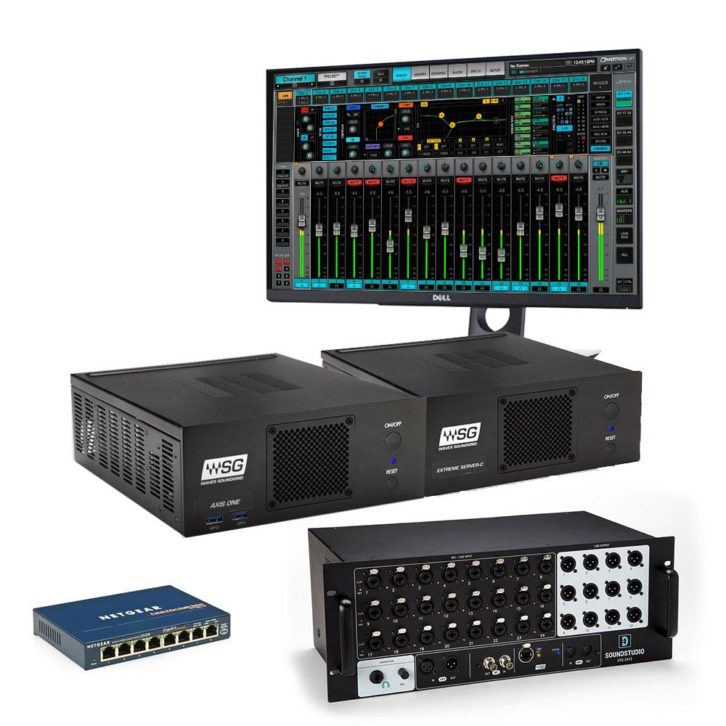 Waves eMotion LV1 is a unique portable digital mixing console for front-of-house based on Waves SoundGrid technology and taking advantage of Waves extensive plugins. Each of the mixer’s channels has its own plugin rack capable of running up to eight SoundGrid-compatible plugins inside the mixer itself. All plugin presets and chains saved in eMotion LV1 can be shared with the Waves MultiRack and StudioRack plugin hosts, enabling users to move seamlessly between live and studio environments. The mixer’s channel strip—its standard EQ, filters and dynamics processing—is provided by Waves eMo plugins (included); the LV1 also integrates with the Dugan Speech automixer plugin (purchased separately). Users control eMotion LV1 using industry-standard hardware controllers, multi-touch screens and portable devices, ranging from four touchscreens to a single laptop or tablet. Also designed for eMotion LV1, MyMon is a free mobile app for iOS and Android devices that gives up to 16 stage performers detailed control over their individual monitor mixes, directly from their mobile phone or tablet.
Waves eMotion LV1 is a unique portable digital mixing console for front-of-house based on Waves SoundGrid technology and taking advantage of Waves extensive plugins. Each of the mixer’s channels has its own plugin rack capable of running up to eight SoundGrid-compatible plugins inside the mixer itself. All plugin presets and chains saved in eMotion LV1 can be shared with the Waves MultiRack and StudioRack plugin hosts, enabling users to move seamlessly between live and studio environments. The mixer’s channel strip—its standard EQ, filters and dynamics processing—is provided by Waves eMo plugins (included); the LV1 also integrates with the Dugan Speech automixer plugin (purchased separately). Users control eMotion LV1 using industry-standard hardware controllers, multi-touch screens and portable devices, ranging from four touchscreens to a single laptop or tablet. Also designed for eMotion LV1, MyMon is a free mobile app for iOS and Android devices that gives up to 16 stage performers detailed control over their individual monitor mixes, directly from their mobile phone or tablet.
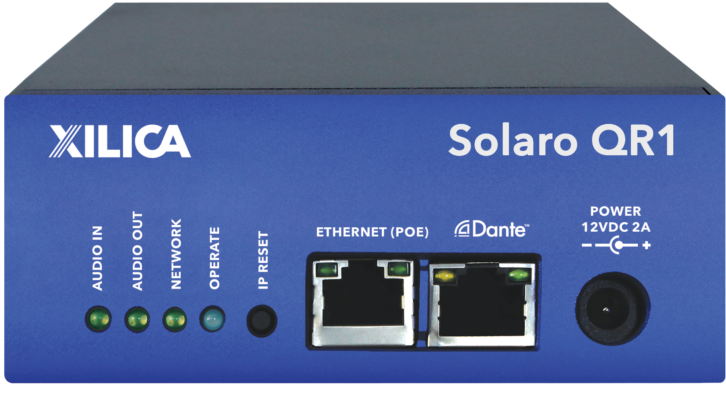 The Xilica Solaro QR1 is a quarter-rack Linux-based DSP processor has eight modular card slots that accept 2-channel audio input and output cards and 4-channel GPIO cards selectable as input or output. The ability to use any card type, in any combination, in any card slot maximizes I/O flexibility, and allows designers to specifically customize I/O without waste. A 4×4 Dante card is built-in. Supported by Xilica’s drag-and-drop Designer, it is compatible with various Xilica control interfaces as well as any third-party control system. External power supply included; also PoE, optional AEC mic inputs up to 8-channels@250ms and 16channels@100ms.
The Xilica Solaro QR1 is a quarter-rack Linux-based DSP processor has eight modular card slots that accept 2-channel audio input and output cards and 4-channel GPIO cards selectable as input or output. The ability to use any card type, in any combination, in any card slot maximizes I/O flexibility, and allows designers to specifically customize I/O without waste. A 4×4 Dante card is built-in. Supported by Xilica’s drag-and-drop Designer, it is compatible with various Xilica control interfaces as well as any third-party control system. External power supply included; also PoE, optional AEC mic inputs up to 8-channels@250ms and 16channels@100ms.
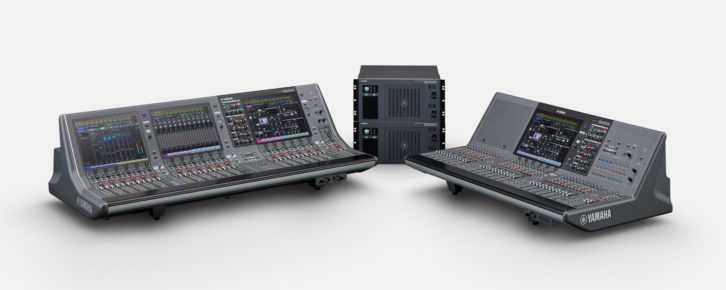 Last May, Yamaha launched two control surfaces and two new DSP engines—the Yamaha RIVAGE PM5 and PM3. The core components of the new RIVAGE PM5 and RIVAGE PM3 are the CS-R5 and CS-R3 control surfaces. Both feature the same fader configuration as the rest of the RIVAGE PM series, with three bays of 12 faders each. The combination of touch screens and selected channel controls offers functionality and intuitive operation familiar to RIVAGE PM series users, while also offering easy entry for users of Yamaha’s CL and QL series consoles. The commonality of fader configuration also means the same layout can be maintained when using different control surfaces, for example on different days of a tour. Designed with multi-operator use in mind, the CS-R5 for RIVAGE PM5 systems features three 15″ daylight touchscreens, and a condensed selected channel section. To maximize the advantage of the screens, the depth of the control surface has been reduced to bring them and the controls for easy reach and improved sightlines. At just 42kg, the CS-R5 control surface is also remarkably lightweight, being easily carried by just two people. The CS-R3 for RIVAGE PM3 systems brings full RIVAGE PM series functionality and performance to a console that measures just 1145mm wide, making it the most compact in the series. The two new DSP units comprise the DSP-RX (120 inputs, 48 mix buses, 24 matrixes) and the DSP-RX-EX (288 inputs, 72 mix buses, 36 matrixes). Like the flagship RIVAGE PM10 and PM7, the PM5 and PM3 offer direct compatibility with Yamaha’s TWINLANe and Audinate’s Dante.
Last May, Yamaha launched two control surfaces and two new DSP engines—the Yamaha RIVAGE PM5 and PM3. The core components of the new RIVAGE PM5 and RIVAGE PM3 are the CS-R5 and CS-R3 control surfaces. Both feature the same fader configuration as the rest of the RIVAGE PM series, with three bays of 12 faders each. The combination of touch screens and selected channel controls offers functionality and intuitive operation familiar to RIVAGE PM series users, while also offering easy entry for users of Yamaha’s CL and QL series consoles. The commonality of fader configuration also means the same layout can be maintained when using different control surfaces, for example on different days of a tour. Designed with multi-operator use in mind, the CS-R5 for RIVAGE PM5 systems features three 15″ daylight touchscreens, and a condensed selected channel section. To maximize the advantage of the screens, the depth of the control surface has been reduced to bring them and the controls for easy reach and improved sightlines. At just 42kg, the CS-R5 control surface is also remarkably lightweight, being easily carried by just two people. The CS-R3 for RIVAGE PM3 systems brings full RIVAGE PM series functionality and performance to a console that measures just 1145mm wide, making it the most compact in the series. The two new DSP units comprise the DSP-RX (120 inputs, 48 mix buses, 24 matrixes) and the DSP-RX-EX (288 inputs, 72 mix buses, 36 matrixes). Like the flagship RIVAGE PM10 and PM7, the PM5 and PM3 offer direct compatibility with Yamaha’s TWINLANe and Audinate’s Dante.
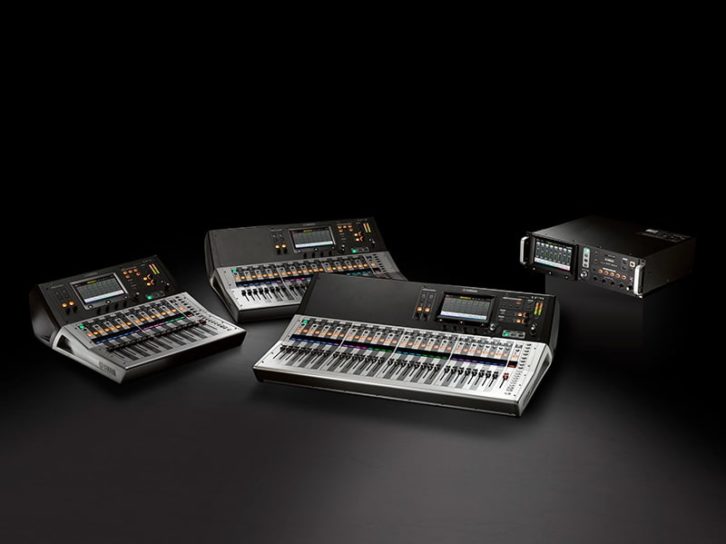 The Yamaha TF Series digital mixers with touch-panel operation gained enhanced control and versatility with firmware update version 4.0. Firmware update V4.0 adds a Selected Channel View that provides access to the main parameters for the currently selected input channel in a single display. Combined with the mixer’s Touch & Turn Knob, this view provides even more intuitive, efficient operation. V4.0 also adds a scene fade time function that offers flexibility for scene management, particularly in theatrical applications. Support for DZR-D and DXSXLF-D Series speakers has been expanded with speaker amp mute control directly from the mixer display. In January, Yamaha also released V5.5 firmware (now V5.51) for the CL/QL series digital mixers. This firmware supports ProVisionaire Control/Touch, the latest Version 3.6.0 enabling complete control over the entire network chain, from mixers through to amplifiers (including Yamaha’s PC Series and the NEXO NXAMP4X4MK2), processors and speakers.
The Yamaha TF Series digital mixers with touch-panel operation gained enhanced control and versatility with firmware update version 4.0. Firmware update V4.0 adds a Selected Channel View that provides access to the main parameters for the currently selected input channel in a single display. Combined with the mixer’s Touch & Turn Knob, this view provides even more intuitive, efficient operation. V4.0 also adds a scene fade time function that offers flexibility for scene management, particularly in theatrical applications. Support for DZR-D and DXSXLF-D Series speakers has been expanded with speaker amp mute control directly from the mixer display. In January, Yamaha also released V5.5 firmware (now V5.51) for the CL/QL series digital mixers. This firmware supports ProVisionaire Control/Touch, the latest Version 3.6.0 enabling complete control over the entire network chain, from mixers through to amplifiers (including Yamaha’s PC Series and the NEXO NXAMP4X4MK2), processors and speakers.


